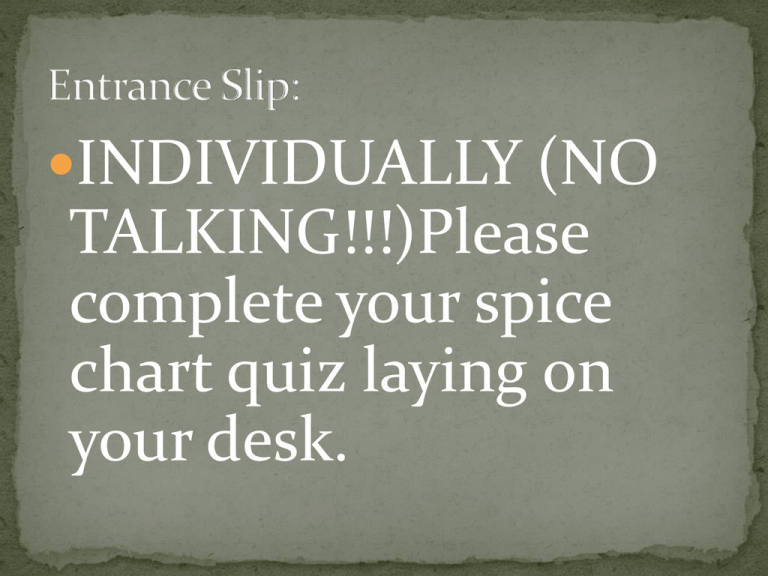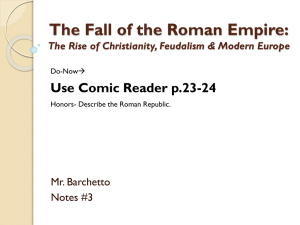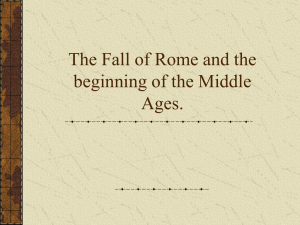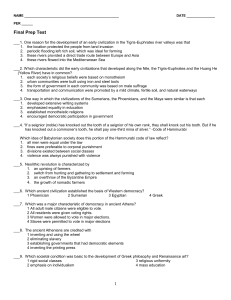Europe in the "Dark Ages"
advertisement

INDIVIDUALLY (NO TALKING!!!)Please complete your spice chart quiz laying on your desk. There are a few places, terms, and dates that you will need to be familiar with before we begin this lesson. In the next few slides, you will get a brief introduction/refresher before we begin. B.C. is a way to mark time B.C. roughly means “Before Christ” This time is referred to as “Ancient History” Lots of important things happened! Hinduism, Buddhism, and Confucianism are begun, Great Wall of China built, First Olympic Games, Pyramids Built A.D. is a way to mark time after Jesus Christ was born. A.D. means Anno Domini, or “Year of Our Lord” Since much of the history studied in the United States comes from a European Christian perspective, we use B.C. and A.D. to mark time. Here are some things that have happened in A.D. Zheng He’s and Christopher Columbus’ voyages, Mayans invented the calendar, microscope invented What services does the United States government provide for you? Try to think of 5 things that the government does for citizens. The Roman Empire lasted from 753 BC – 476 AD They are considered a great empire for their engineering, government, intellectual development, and leadership conquest. Here are some images you might associate with the Roman Empire: Looking at the map, what issues do you see with the Roman empire that could be problematic? Why do you think the empire fell? To end the Roman Empire, many nomadic (roaming) warrior tribes invaded. Some of these tribes were the famous Huns, Goths, and Vikings. They were known to bring terror to towns where they invaded. The “Middle Ages” are considered the time “in the middle of” the Roman Empire’s fall and European’s dominance in exploration Europeans were no longer leaders in SPICE characteristics. Anything in this time period is called “Medieval” Here are some images you may associate with the “Middle Ages”. These are the years we will be studying in this unit. Roughly 500 ends the Roman Empire/European dominance and 1450 begins sea exploration and the reemergence of European dominance During these years Middle Eastern/African, Asian, and American civilizations made many great advances while Europe declined that’s what we will study during this unit. History Channel’s The Dark Ages Let’s take a look at a video that will visualize all of the changes, terms, dates, and events that we have just seen! Answer the questions that accompany the first 22 minutes of the video on your paper. http://youtu.be/C8XVW NygDVk Describe life after the fall of Rome. With the Absence of Government, who did the people turn to for hope? What potential problems do you see with the church becoming the political and religious power? Pretend you are a citizen living in Rome, the government falls to the Visigoths and many different warriors/military soldiers come in to start claiming land. The are not friendly and you as a citizen must protect yourself and make sure you have the basic needs to survive. What do you do? How do you ensure that you stay safe? How will you make sure to stay safe? How will you protect yourself? What is Feudalism? Describe why it was created. Why was Feudalism created? Who benefitted from the system? Put the following groups in the appropriate hierarchy order. Most powerful to least powerful. Pope, Peasants, Knights, Kings, If you lived during the Middle Ages, who would you want to be? Why? What social class would you not want to be? Why? King Lords/Nobles (Landowners) Knights (hired by lords) Serfs - worked the land for protection 90 % of population What was life like in the dark ages? How did the people adapt to the fall of Rome?










